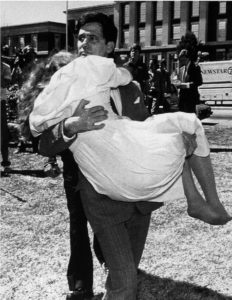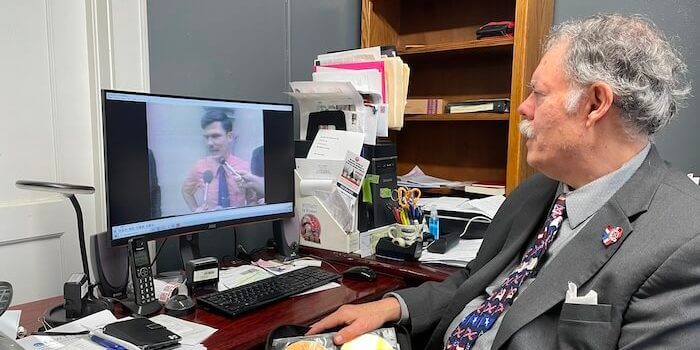(Ken Silva, Headline USA) More than 30 years before the Oath Keepers and Proud Boys were charged with seditious conspiracy in relation to Jan. 6, 2021, another group of right-wing dissidents was on trial for allegedly conspiring to overthrow the U.S. government.
Unlike the Jan. 6 defendants, the right-wingers from the 1988 Fort Smith sedition trial were acquitted on all counts.
Kirk Lyons, an attorney from the 1988 case, recently talked to Headline USA about how the defendants were able to successfully take on the government more than three decades ago, and what has changed since then.
Gordon Kahl and The Order
The 1988 Fort Smith sedition case stems from the FBI slaughtering a tax protestor who had killed two U.S. Marshals in a shootout in February 1983. The protestor, Gordon Kahl, had gone on the lam following the shootout, and the FBI mutilated and conflagrated his body when agents finally tracked him down.

Kahl’s death inflamed the far-right movement at the time.
“I remember when Gordon Kahl was killed, and that really set off a ripple among the right wing. ‘Damn, are they going to kill us all?’ is what they thought,” Lyons said of the early 1980s right-wing dissident movement.
“And it militarized a lot of thinking. People were thinking, ‘We’re going to have to resist at some point, or else they’re going to murder us in our beds.’”
In direct response to the Kahl killing, a legitimately terroristic group known as The Order was formed later in 1983, going on to assassinate a Jewish radio host and rob millions of dollars from banks with the goal of funding a right-wing insurgency. The group’s leader, Bob Matthews—whom the FBI also killed and conflagrated in December 1984—cited Kahl’s murder in a declaration of war he drafted against the federal government.
Following The Order’s takedown in December 1984, the U.S. government convicted 10 of its members under Racketeer Influenced and Corrupt Organizations Act statutes. Additionally, two members were convicted in a separate trial for the assassination of the Jewish radio host.
However, the U.S. government was criticized for only prosecuting the foot soldiers of the right-wing insurgency, as extremism researcher Kathleen Belew put it. The 1988 sedition trial was aimed at the movement’s leaders—including controversial former Texas Ku Klux Klan leader Louis Beam, who ended up being Lyons’s client.
Lyons said Beam first approached him in 1985 to be his attorney. Beam apparently had already been tipped off that he was about to be indicted for sedition.
Beam wouldn’t be indicted for about another two years, and by that time he had taken his wife and daughter down to Mexico.
Lyons said the FBI surveilled his home and questioned him about Beam’s whereabouts, but the lawyer said he didn’t know where he was.
A Mexican Shootout
Then, on the night of Nov. 6, 1987, Lyons received a phone call from Beam’s daughter. Mexican authorities had raided Beam’s Mexican property, and Beam’s wife shot one of the agents—thinking that he was a robber.
“Her dad told her to memorize my number and call me as soon as she got out of Mexico,” Lyons said of Beam’s daughter.
Lyons told Headline USA previously unpublicized details about of what happened in Mexico. The lawyer’s info comes from his friend and former colleague David Hollaway—a pilot who worked for a CIA front company in the 1980s, reportedly claimed inside knowledge of the Oklahoma City bombing in the 90s and, bizarrely, currently works as a contractor for NASA.
Lyons said he sent Hollaway to retrieve Beam’s wife from Mexican prison.
“The FBI tailed one of Louis’s buddies who went to give him money so he could make do. The FBI followed him, and then tracked Louis to Chapala. Apparently, the FBI had energized the police is Guadalajara by telling them Beam was a drug lord. They had every drug agent in the region. According to my friend Dave Hollaway, they had a company of infantry soldiers—Yaqui Indians with machine guns,” Lyons said.
“So they raided the house. What’s ironic and tragic is that Louis got there, he went inside and checked to burglars and bandits. He came back out and Sheila [his wife] went inside. It was at that time when the raid hit. They got Louis immediately. Only Sheila’s in the house, and it’s dark,” he said.
“They sent their Mexican agent who spoke English to get her out. He just said, ‘Get down here.’ She found the pistol she was trained to use. He was coming upstairs with a shotgun. She wouldn’t comply because she didn’t know who this guy was, opened fire, and put two rounds in him and took out half of his liver.”
In response, the “Yaqui Indians with machine guns” outside opened fire, spraying some 500 rounds into the Beam residence, according to Lyons.
It was after the gunfire stopped that Sheila’s troubles began, the lawyer lamented.
“Many bad things happened to her. I think she was tortured and worse,” he said, declining to go into the gruesome details. “And that all happened with the FBI in the next room … The FBI didn’t lift a finger because if she’s in a Mexican prison, that’s pressure they can put on Louis, who is on a short trip to the U.S.”
How Sheila was eventually released from prison remains something of a mystery.
Lyons said his initial understanding is that Mexican authorities were furious that the FBI misled them that Beam was a drug lord, apparently releasing Sheila because they didn’t want to deal with her. A Mexican judge ruled that she acted in self-defense.
However, Lyons said FBI Agent Norm Stephenson later told him that former KKK leader Tom Metzger bribed Mexican authorities with proceeds of The Order’s multimillion dollar armored-car robbery.
“Take it with a grain of salt, but [Stephenson] told me that Tom Metzger put up the money to get her out … Money from The Order. That’s what Norm Stephenson said. I didn’t believe it, but that’s what he told me,” Lyons told Headline USA.
“I told him, ‘It’s still a miracle.’ We thought we’d never get her out of there. That’s what brought me back to the Lord.”
In any event, Beam’s Mexican ordeal ended up benefitting him at the 1988 sedition trial.
Sedition Trial
Beam caught an early break when U.S. Judge Morris Arnold tossed evidence mishandled by Mexican authorities.
But what really collapsed government’s case was its use of unreliable snitches.
Government’s witnesses included James Ellison, a former militia leader affiliated with The Order, who had turned on his former colleagues in exchange for a lighter sentence for his activities as the leader of his militia, The Covenant, The Sword, and the Arm of the Lord.
According to Lyons, his client and other defendants in the sedition trial all signed a document, under the impression that it would put them on a mailing list for Ellison. But Ellison told authorities that the document was, in fact, a declaration of war against the government.
During the trial, Ellison was reportedly caught lying on the stand multiple times, including when he accused one of the defendants of buying explosive materials when that defendant had already been in jail.
Another government witness, Glenn Miller, was implicated by the defense as having been involved in several murders at a Shelby, North Carolina porno store in 1987, according to journalist Arthur Bloom. Miller, who died in 2021, would later shoot up a Jewish community center in 2014.

Lyons said Beam’s acquittal was one of the proudest moments of his career.
“As far as I know, he’s the only person to make the FBI’s Most Wanted list that was acquitted,” Lyons said.
Critics have blamed a lenient judge and friendly jury for the acquittals—one of the jurors wound up marrying a defendant after the trial—but Lyons said that’s because the Justice Department made the defendants likeable.
“They brought in a lot of The Order’s wives to testify against them … I don’t think the jurors liked that, because those guys were already in prison,” Lyons said, mentioning one of the particularly tactless strategies employed by DOJ prosecutors.
Further responding to critics, Lyons noted that the sedition trial’s venue—Fort Smith, Arkansas—was where the government had already successfully prosecuted multiple members of The Covenant, The Sword, and the Arm of the Lord. The fact that multiple CSA members were successfully prosecuted in Fort Smith should put to rest the notion that jurors there were in alliance with the right-wing militias, Lyons argued.
When it came to sedition charges, the DOJ just bit off more than it could chew, Lyons contended.
To Lyons’s point, the FBI agreed with him at the time.
“The bottom line was, the jury couldn’t understand how a dozen people could get together and overthrow the country,” said Horace Mewborn of the bureau’s domestic terrorism unit, according to the book, Oklahoma City: What the Investigation Missed, and Why it Still Matters. “We learned that the hard way at Fort Smith.”
Lessons Learned
Nevertheless, Lyons said he thinks the Fort Smith failure taught the government a valuable lesson: “If you’re going to use sedition, put it in a venue like Washington DC. That’s the lesson.
“And you’re not going to get a jurist like Morris Arnold let loose in DC. They learned that lesson: Be careful who the judge is. They might actually believe in all that shit [constitutional rights],” he added.
Lyons added that the events of Jan. 6 fail to even come close to seditious conspiracy.
“Calling that an insurrection is absolute bullshit. But they got a venue where they could make it work,” he said.
“They’re doing it because they can. They’ve just become a little more naked with their Stalinist show trials in the 2020s than they were in the 1980s.”
Ken Silva is a staff writer at Headline USA. Follow him at twitter.com/jd_cashless.

